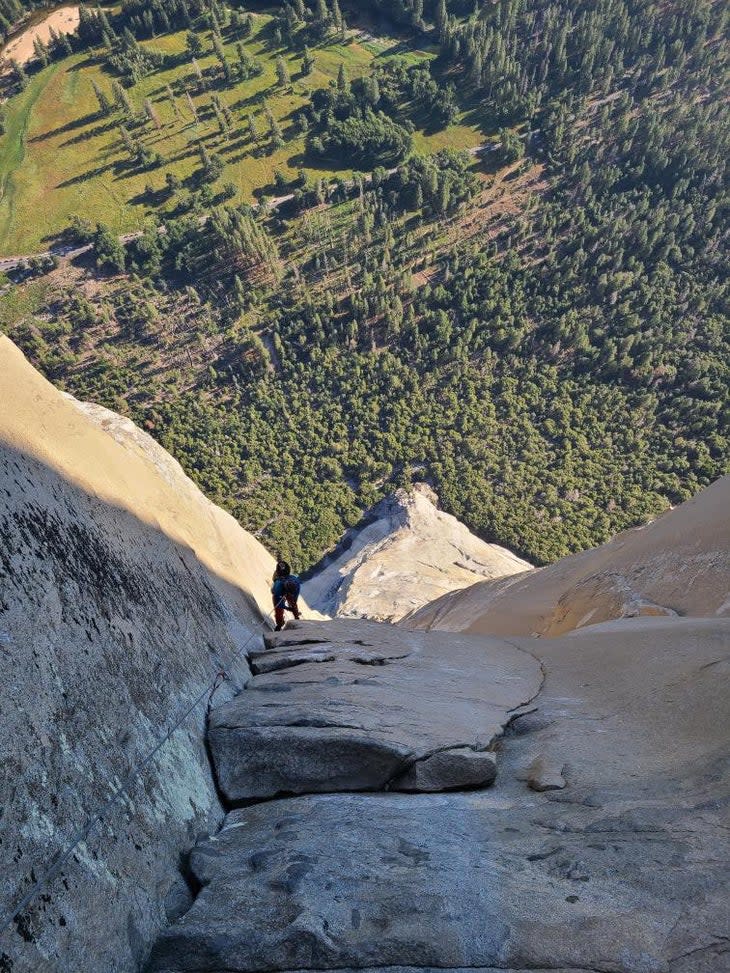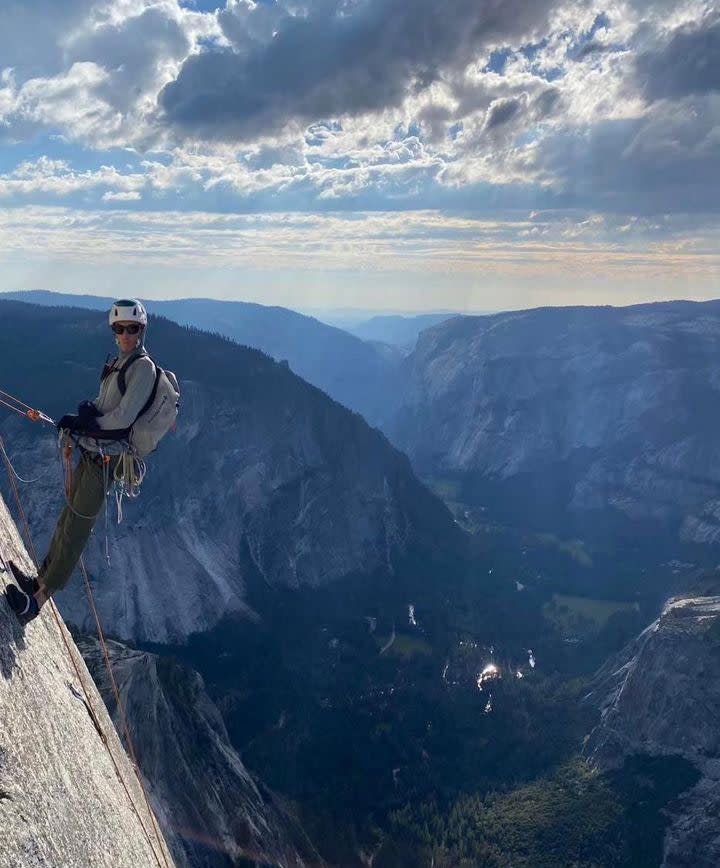20 Classics in 20 Days Challenge Repeated 30 Years Later
This article originally appeared on Climbing
Between August 8 and August 23, 2023, Aidan Multhauf (28) and David Katzenmeyer (33) repeated Hans Florine's 1993 linkup of 20 Classics in 20 Days. The duo completed the mega linkup to Florine's team in reverse order, beginning in Wyoming and ending in California. The endeavor totaled 224 pitches of technical rock, 63,000 feet of elevation gain, 140 miles of hiking, 2.5 hours of canoeing, and 3,361 miles of driving.
Katzenmeyer, a climbing guide in Moab, Utah, got wind of the idea after taking an AMGA Rock Guide course with Christian Santelices in 2020. Santelices, now an IFMGA-certified mountain guide, was part of the 1993 team with Florine, including Nancy Feagin and Willy Benegas; they climbed in two teams of two, swapping out leads and simul-climbing.
Multhauf, a climbing guide and graphic designer at Sharp End Publishing, has always been inspired by big linkups and endurance challenges. Katzenmeyer considers Multhauf one of his most trusted climbing partners, having tackled big projects like Positive Vibrations (5.11a; 1,200ft) on the Incredible Hulk and worked pitches of Freerider (VI 5.13a PG13; 3,300ft) together in the past. "Aidan was the obvious partner for this," Katzenmeyer told me. They each had their specialties in various climbing disciplines, and the 20 Classics Challenge would require every weapon in their climbing arsenal. Katzenmeyer had recent knowledge of many Yosemite climbs on the roster and took the sharp end on cracks and offwidths, while Multhauf was the better face climber and endurance athlete and kept morale high on the longest days.

On August 8, 2023, the pair began the challenge on Durrance (5.7+; 500ft), on Bear Lodge (Devils Tower), Wyoming--almost 30 years ago to the day, Florine, Feagin, Santelices, and Benegas were celebrating their successful completion with a campaign breakfast and a nice, long nap in the back of their 1976 GMC Van.
I called Florine on spotty reception from Ten Sleep, Wyoming. He answered from El Cap Meadow. "The crux of our attempt was getting started," Florine told me, "Once you get the momentum going, you just focus on what's next--but starting, well, it's difficult to start something when you know there is a high chance of failure."
Failure loomed large on Multhauf and Katzenmeyer's minds early on. After Bear Lodge, they drove across Wyoming to Grand Tetons National Park to tackle Mount Moran via the Direct South Buttress (5.9; C1; 1,500ft) and the Grand via Exum Ridge (5.5; 1,700ft). In a dizzying array of spreadsheets, maps, and meal preps, Multhauf and Katzenmeyer had their logistics planned down to the hour. To succeed, they must operate under little sleep and non-stop climbing, hiking, and driving. By coupling easier climbs together, they factored in three rest days. Two after their longest days on day 11 after Mount Whitney and Lover's Leap, and day 18 after completing the Nose-in-a-day (NIAD) and one full day of driving. Any mishap, an unplanned bivy, or getting lost on the descent could cost them success.

Katzenmeyer and Santelices kept in touch after the Rock Guide course. "Christian was crucial to our success," Katzenemyer emphasized. Support from one of the few people who have succeeded in the challenge was vital in keeping Katzenmeyer and Multhauf hopeful and motivated. Santelices had a canoe waiting for the pair when they rolled into Jackson Hole, which they promptly took to paddle across String and Leigh Lakes to reach the base of Mount Moran.
I called Multhauf on August 11 to check in on their progress. They were en route up to Exum Ridge but already behind schedule. The descent off Mount Moran is notoriously tricky, even more so in the gathering darkness. "We could not find a descent, so we spent a few hours at the top, trying to locate a descent," Multhauf said, "We finally found some old tat, and chased that down eight double-rope repels of absolute terror." Multhauf and Katzenmeyer did not return to camp until 11 p.m., and they were due to begin the approach to Exum Ridge at 1 a.m. That plan was toast. They took a long rest, realizing that their delay in descending Mount Moran cost them precious time they now had to make up by giving up their rest day. The pair could not rest until day 17 to stay on schedule--they were on day 3. A slight twinge of pessimism hung over the conversation.
Another crux, Florine said, is fighting fatigue. "You're going to be completely dead tired at some point. Or your partner is going to be. The tiredness may not hit at the same time. You need a strong relationship to weather this, and communication is a key factor to success."
It was a silent drive from the Grand Tetons to the Wind River Range. They quietly wondered if all hope was lost before they even began.
After descending the Northeast Face (5.8+; 1,200ft), on Pingora, and the East Ridge (5.6; 1,000ft), on Wolf's Head in the Wind River, they were off to the Colorado Rockies for South Face (5.8; 1,000ft), on Petit Grepon, and Ellingwood Ledges (III; 5.7), on Crestone Needle. They deviated from the 1993 team by skipping the D1 on Longs Peak and swapping it for Finger of Fate (5.8, C2+; 900ft) on the Titan. Neither had done Finger of Fate; both had it as a bucket list climb. The Northcutt-Carter Route was also omitted after rock fall altered the route; they would swap it out for Charlotte's Dome later.

Due to the unexpected delay on Mount Moran, the pair frantically looked for a timed-entry reservation for Rocky Mountain National Park on their smartphones en route. "We did not have to deal with reservation systems back in 93," said Florine, "but we did not have the help of smartphones or GPS technology. We had one cellphone the size of a shoebox."
The ability to call loved ones for support was another crucial factor to success. Multhauf called his partner, Katie Ratko, frequently. The pair had gotten engaged on Longs Peak a few weeks prior.
Without a hitch, Multhauf and Katzenmeyer ticked off their Utah climbs, Castleton via Kor-Ingalls (5.9; 400ft) and Titan, and began the long drive to California. Emotions were running high, bringing a mixture of awe, veneration, and wondrous giddiness-they were approaching the halfway mark. Their excitement was short-lived, however, because Hurricane Hilary was brewing in the Pacific.
"We were coming off Whitney with the storm at our backs when I slipped on ice," said Katzenmeyer, "I landed hard on my side and had the wind knocked out of me. I knew something was wrong."
It became clear that Katzenmeyer had cracked a rib. Deep breaths were painful, and core tension was hard to maintain while climbing. Multhauf expressed a tantalizing moment of relief. Multhauf had been battling a quiet fear--a mistake on his part could cause them to fail. With an injury, they could declare force majeure, and it would be no one's fault.
“You don’t need that rib to climb, I’m finding out,” joked Katzenmeyer. After a detailed assessment back at camp, Katzenmeyer decided he could push on. The same day after descending East Face, on Mount Whitney, they raced Hurricane Hilary up the coast. They arrived in Tahoe to tick off Lover’s Leap via Traveler Buttress (5.9; 500ft) the same day before sprinting to Yosemite, where their biggest day lay ahead.
“NIAD was the single most challenging day of the trip,” Multhauf told me via text, “technical systems became reflex, and we moved efficiently until we reached the Changing Corners. We were overtaken by ‘the claw,’ Our arms cramped so badly we couldn’t open and close our hands, rendering French-freeing useless. There was no more love for the day, route, or sport. We were motivated by a single string of bandwidth and the precious sleep we could squeeze out at the end of the day.”
I asked Katzenmeyer about sleep deprivation and the dangers it could pose on the wall. Florine had been floored when he considered the 3,000-plus miles driven between two people. It was difficult enough with four. Katzenmeyer's response mirrored Florine's concern, "The endorphins and movement kept us aware and alert on the wall, and I believe the biggest danger we faced was during our drives. We had to keep each other alert."
Multhauf and Katzenmeyer’s last climbs, Clyde Minaret via the Southeast Face (5.8; 1,500ft), and Charlotte’s Dome via the South Face (5.8; 1,500ft), were done as a race against the midnight hand. They tagged the car and dropped their packs, but instead of collapsing on the ground, they paced around the car in a frenzied panic. "Did we just do it? Did we actually do it?" They could not stop the fits of disbelieving, hysterical laughter for a long time.
"It was one of the most special things I've done," says Santelices, "I feel honored that David and Aidan took inspiration from my story and went after it themselves. Maybe they’ll go for all 50 classics someday.”
When I asked Multhauf and Katzenmeyer why they wanted to do this, they laughed and answered dcasually. "It's rad--why else?"
Also Read
For exclusive access to all of our fitness, gear, adventure, and travel stories, plus discounts on trips, events, and gear, sign up for Outside+ today.

